Featuring the 300L and 2x extender
Oct 18, 2018 09:31:54 #
This post continues the discussion of Canon L-series lenses used with Canon Series III extenders, showing examples from the Canon EF 300mm f/2.8 IS II USM and the EF 2x III Extender creating a 600mm focal length combination.
The EF 300mm f/2.8 lens refers to a family of 300mm telephoto prime lenses made by Canon going back to manual focus versions first released in 1974. The lens is commonly used by sports and wildlife photographers, but is short enough for use in extreme close-up portraits. Because of its rather high native magnification, the EF 300L can also be used for macro type photography.
The sandhill crane (Antigone canadensis) is a species of large crane found in North America and extreme northeastern Siberia. The common name refers to habitat along the Platte River, on the edge of Nebraska's Sandhills on the American Plains. Sandhill cranes are fairly social birds that usually live in pairs or family groups throughout the year. During migration and winter, unrelated cranes come together to form "survival groups" that forage and roost together. Such groups often congregate at migration and winter sites, sometimes in the thousands.
Sandhill cranes by Paul Sager, on Flickr

The largest living bird, the ostrich can reach up to nine feet tall and 285 pounds. The species has a black chest and wings, a white underside, and long, bare neck and legs. Because of its large size, the ostrich is unable to fly.
Ostrich

Introduced in 1987, the EF lens mount is the standard lens mount on the Canon EOS family of SLR film and digital SLR cameras. EF stands for "Electro-Focus". Automatic focusing on EF lenses is handled by a dedicated electric motor built into the lens. Mechanically, it is a bayonet-style mount, and all communication between camera and lens takes place through electrical contacts; there are no mechanical levers or plungers.
Chilean Flamingo
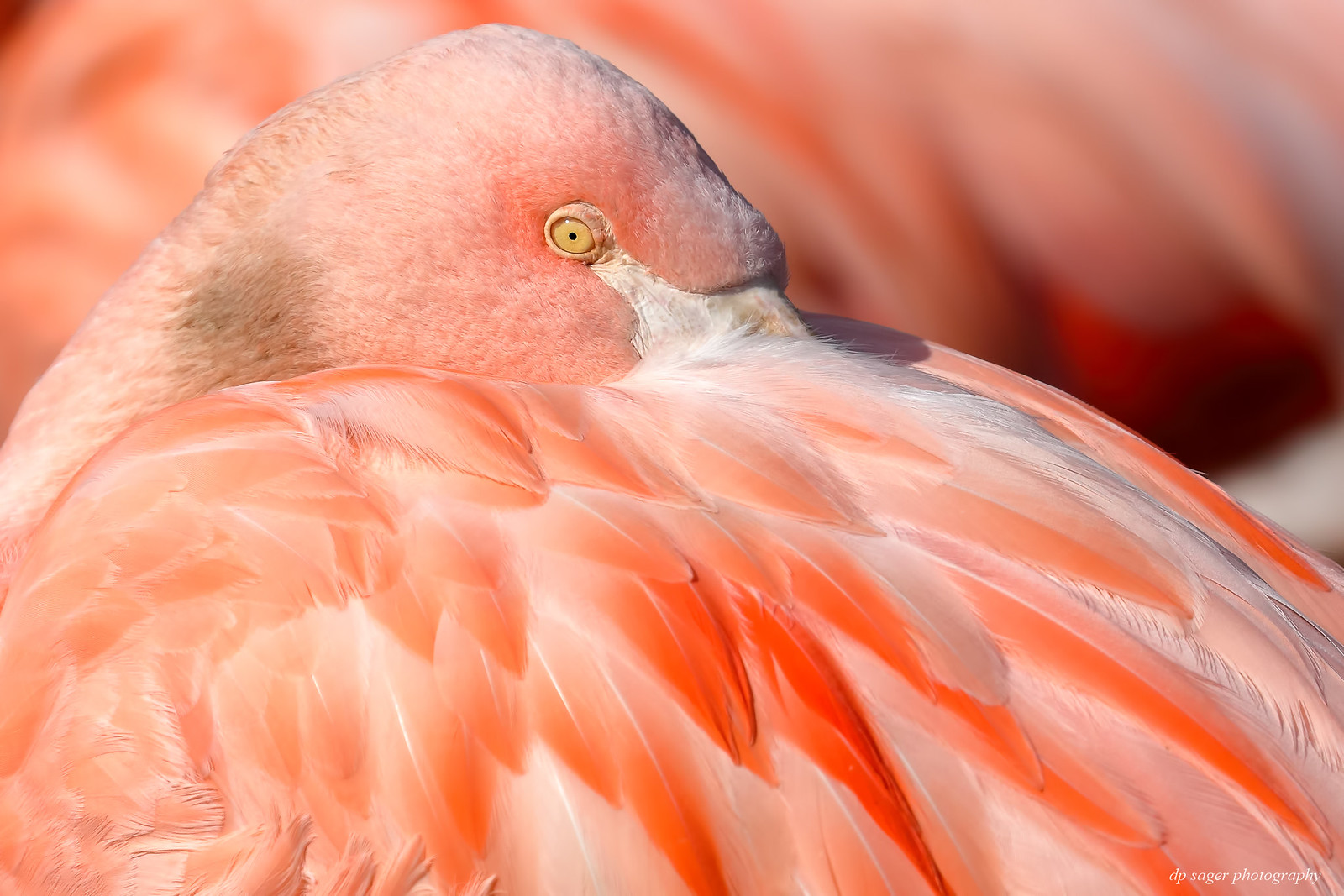
All EF lenses have a maximum aperture of f/5.6 or wider, so all EOS cameras will autofocus with any EF autofocus lens. The f/8 auto focusing ability is only needed when using a lens and extender combination that reduces the maximum aperture of the lens to f/8 or smaller. The Series III extenders are designed to provide faster auto focusing and improved autofocus precision with compatible EF lenses. Both the 1.4x and 2x extenders feature a new microcomputer to increase AF precision when used with Series II EF super-telephoto lenses.
When using Canon extenders, Canon recommends the Series III extender be attached first to the lens, before attaching the whole unit to the camera. This ensures the combined lens information is transmitted correctly to the EOS camera to provide the optimum image quality and focus performance.
The Schmidt's red-tailed monkey is a small guenon characterized by a distinctive white or yellow nose, white cheeks, and a long red-tipped tail. Guenon is the French word for monkey. Red-tailed monkeys have large cheek pouches that can store almost as much food as their stomachs. They pack food into their cheek pouches and move quickly to another location to safely consume their food away from other monkeys that may try to steal it.
Red-tail Guenon

When the EF mount was introduced in 1987, it had the largest mount diameter (54 mm internal) among all 35 mm SLR cameras. The large diameter and relatively short flange focal distance of 44.0 mm allows mechanical adaptation of EF camera bodies to many types of non-EF lenses. It is possible to mount lenses using the Nikon F mount, Olympus OM, Leica R and universal M42 lens mounts (among others) by the use of a mechanical adapter without electronic control of the aperture or autofocus.
Lenses for the earlier Canon FD lens mount are not usable for general photography on an EF or EF-S mount camera, unless adapters with optical elements are used because the FD flange focal distance was only 42.0 mm. The Canon FD-EOS adapter is rare and is only usable with certain FD telephoto lenses. With a manual connection, the aperture and focus controls of the lens cannot be controlled or read from the camera; the lens must be focused manually. Since the only possible metering is through-the-lens, the lens must be manually stopped down to accurately meter at anything less than full aperture. (This is called stop-down metering.) With the introduction of the Canon EOS-M mirrorless digital camera, an inexpensive adapter allows the full use, including infinity focusing, of nearly all FD and FL lenses.
Blue Morpho Butterfly
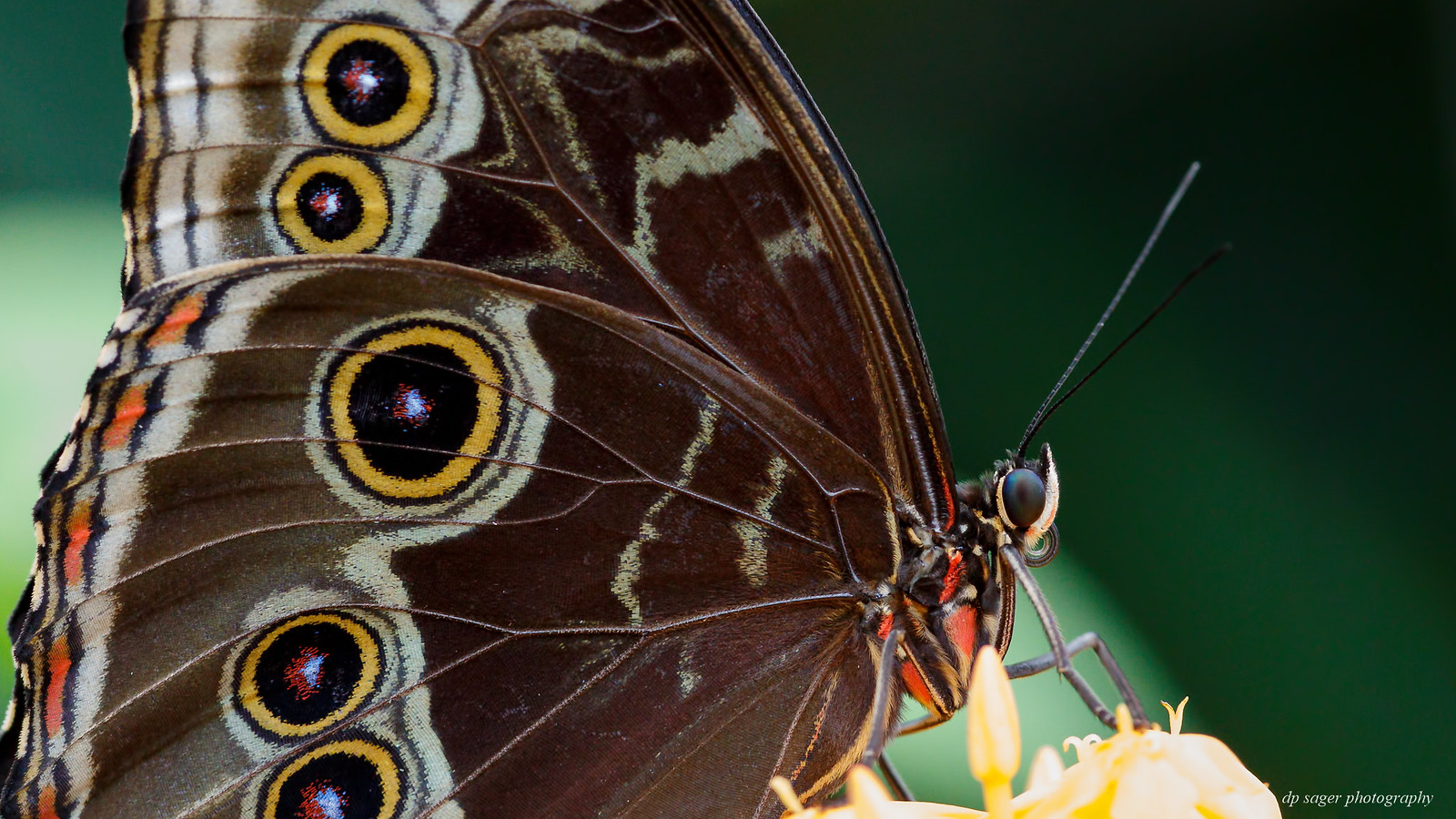
One of the Batman's unique crime fighting tools was the Batcopter, which first appeared in the 1966 film Batman. The Batcopter is a retrofitted Bell helicopter leased by 20th Century Fox for the movie. Initially owned by National Helicopter in Van Nuys, the helicopter was used in a number of films and television shows, including The Green Hornet, Omega Man, and MASH. Unlike the Batmobile, the original Batcopter is fully operational and continues to travel around the country appearing at airshows and conventions, and is available for private bookings.
Batcopter N3079G
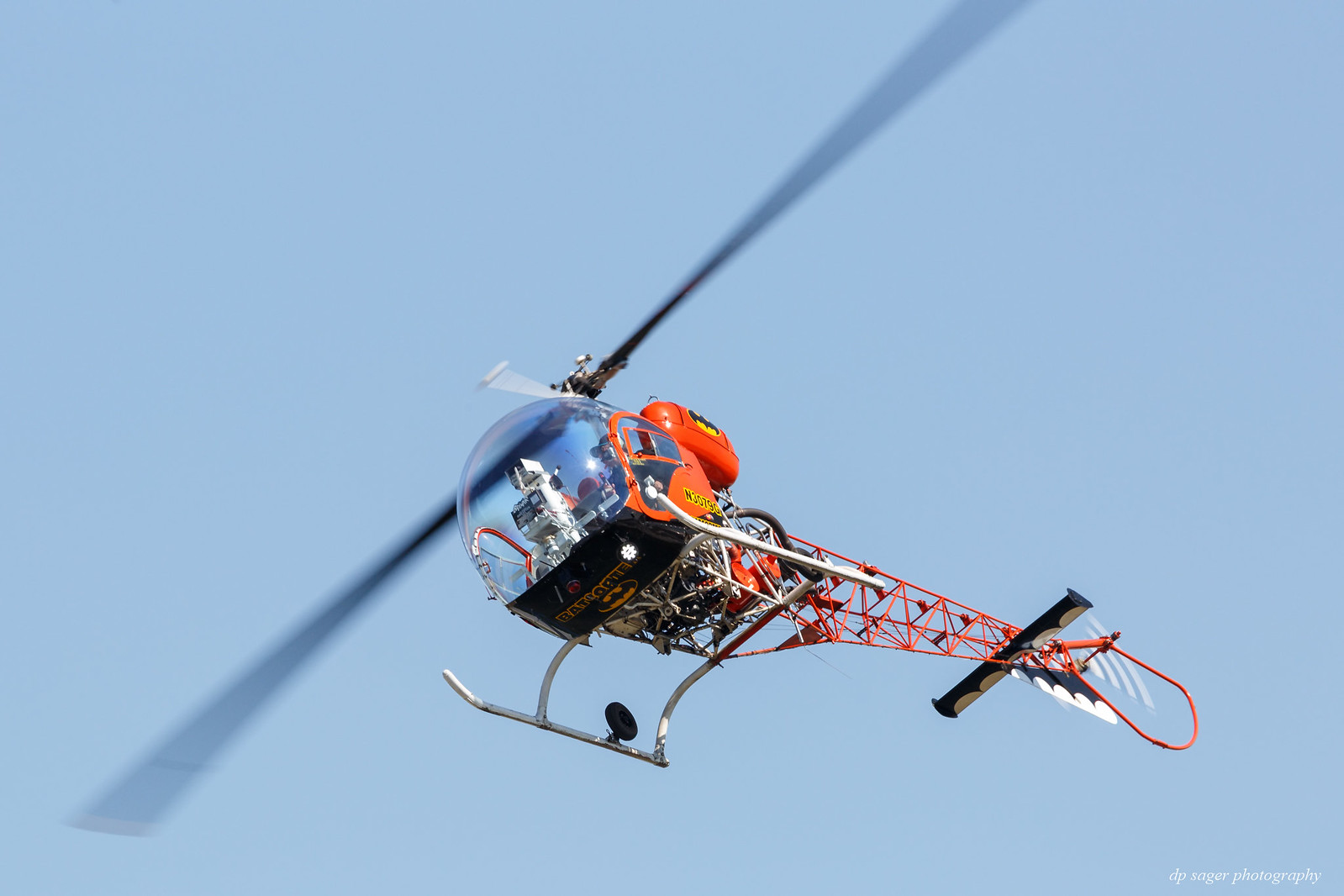
The Canon L-series lenses are the pinnacle of the company’s lens technology. Designed for professional use, they incorporate the latest available lens technologies. Superior optical performance is only half the story. A lens destined for professional use must also withstand the rigors of a working professional photographer. A rugged build quality is needed to endure the hard-knocks of everyday use, and weather sealing is needed to protect against adverse conditions. The L-series lenses feature a liberal use of rubber sealing at interface areas, such as the lens-to-camera junction, external switches, and around zoom and focus rings to prevent moisture from getting in and destroying the lens’ electronics.
Bill Stein has performed at air shows across the United States since 1995, both as a solo performer and as a member of several performance teams. Bill's Edge 540 uses cutting edge paint technology that continuously changes color based on the constantly varying angles between the spectators, airplane, and the lighting. The same part of the airplane will change color from green to purple to blue along with gold, yellow, pink, and orange depending on the angle of the light and the perspective of the viewer.
Bill Stein
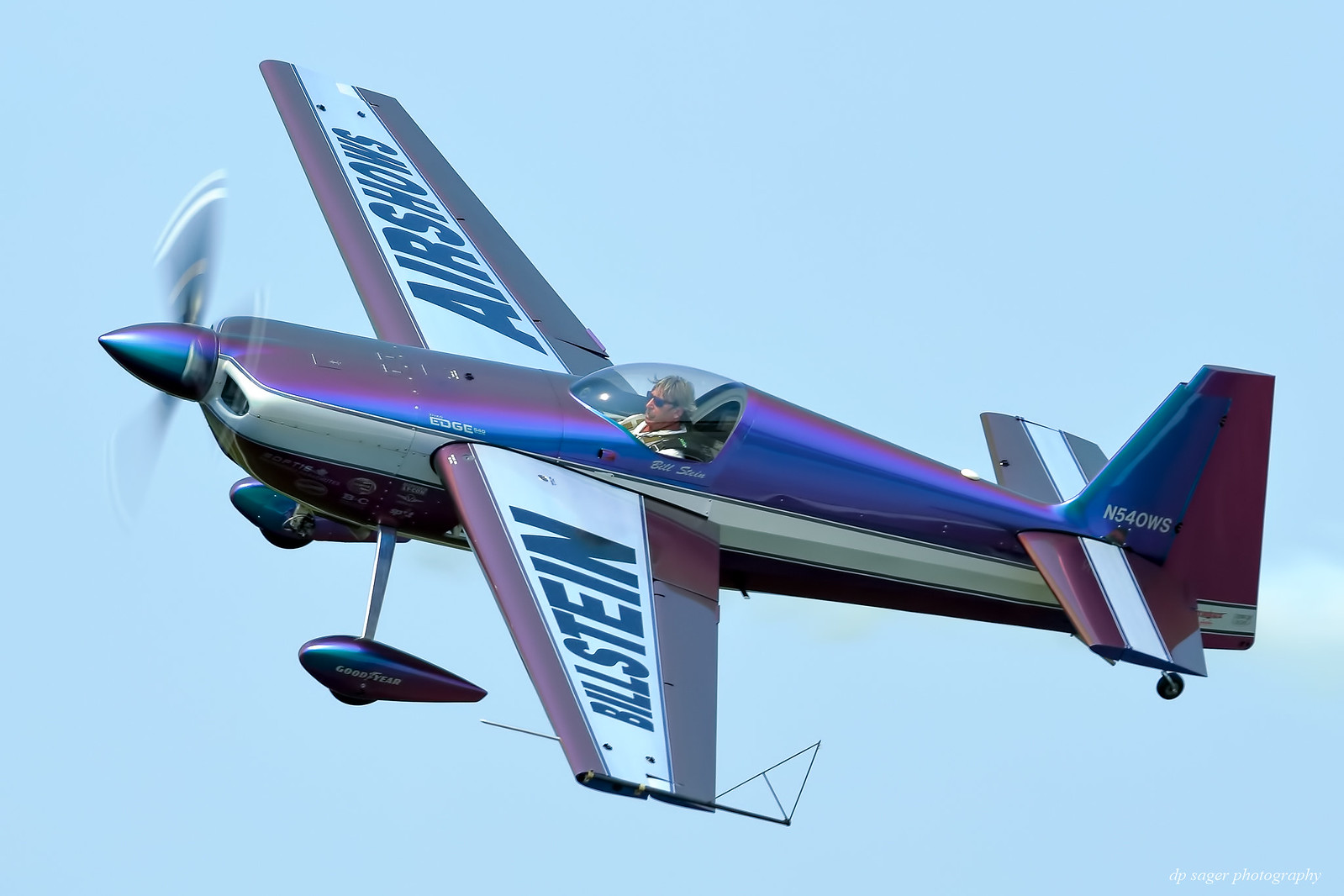
The Canon EF 300mm f/2.8L IS II USM comes from a family of high performance 300mm lenses dating back to the 1974 release of FL 300mm f/2.8 S.S.C. (Super Spectra Coating). The FL mount was Canon's lens mount standard for 35mm single-lens reflex cameras from 1964 to 1971, when the FD mount was released. Unlike the FD to EOS transition, FL lenses can also be used on FD-mount cameras. The FD 300mm f/2.8 S.S.C. fluorite was released in 1975 featuring a combination of a fluorite lens element and optical glass elements to control chromatic aberration. The FD 300 SSC also debuted Canon's new automatic diaphragm control for large aperture telephoto lenses, which was previously considered impractical due to the time lag of the diaphragm blades. The new FD 300mm f/2.8L, released in 1981, was one of the most highly regarded super telephoto lenses of the 1980s. These 30+ year old lenses now sell for around $800 on ebay, with prices rising due to their rejuvenation on mirrorless cameras.
The EF 300 f/2.8L USM continued the 300mm tradition using autofocus technology on the new EF mount. In the early days of autofocus photography, the AF drive motor was placed in the camera body and the camera drove the lens mechanically. With the introduction of the EF lens mount in 1987, the fully electronic connectors allowed the autofocus motor to be moved from the camera body to the lens itself, giving the possibility that each AF motor could be tailored to suit the lens it was fitted into, thereby providing faster autofocus. The result was the EF 300mm f/2.8L USM lens launched at the start of the EOS system in 1987. The lens featured a ring-type Ultra Sonic Motor (USM) motor that was both fast and near silent.
Image Stabilization was added to the 300L in 1999 and the current Series II model was released in 2011.
Chicago Lion
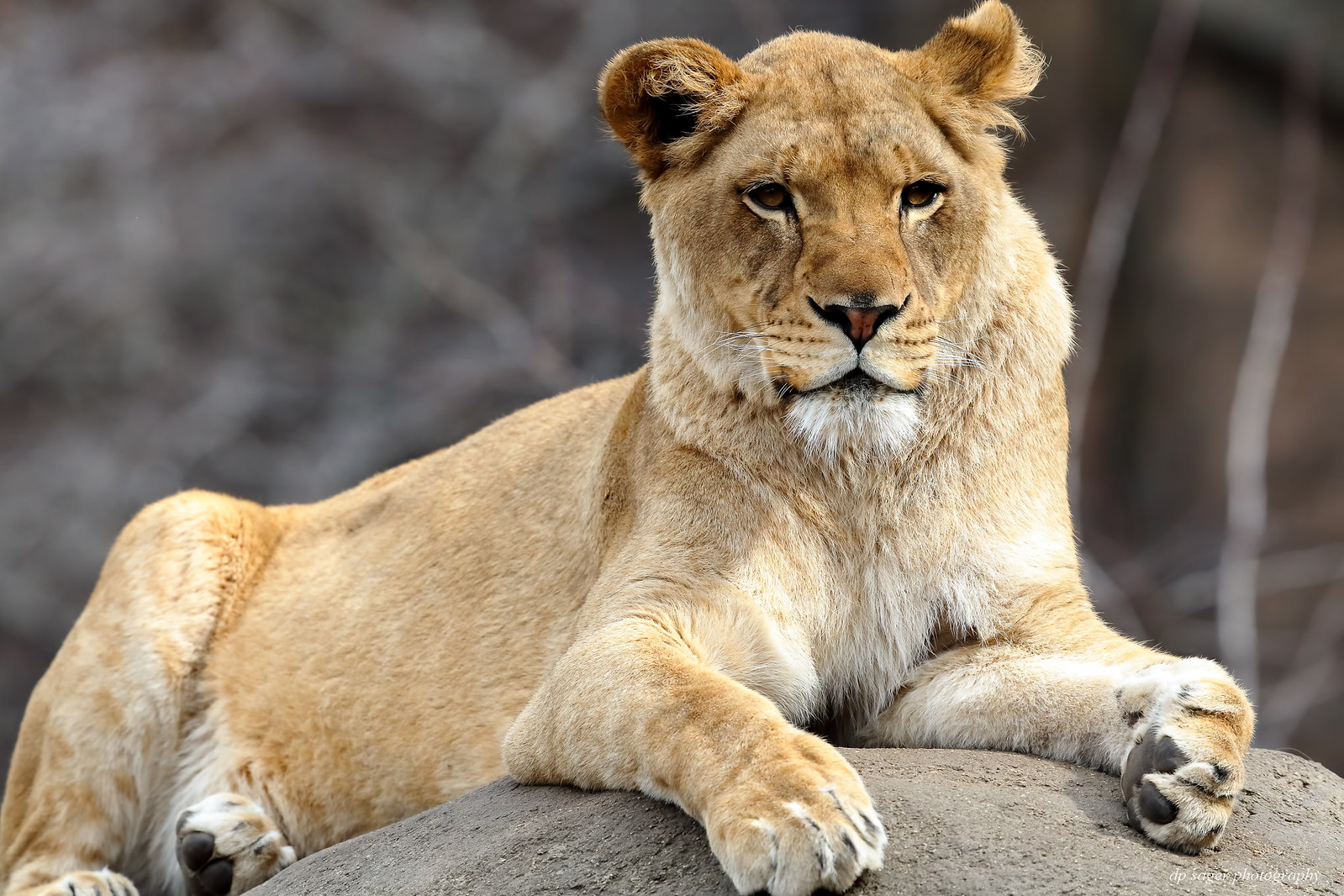
The images are sized to fill your wide-screen display. Try using <F11> to maximize your browser window for the full effect. If the images overshoot your display, such as a laptop, just click on the image or the URL link and they'll resize to your screen from the host Flickr site. You can click a bit further into the image details on the Flickr page, if desired. EXIF data is available from the host Flickr pages as well. On the Flickr site, use your <L>key for Large and the <F11> for the full-screen.
The EF 300mm f/2.8 lens refers to a family of 300mm telephoto prime lenses made by Canon going back to manual focus versions first released in 1974. The lens is commonly used by sports and wildlife photographers, but is short enough for use in extreme close-up portraits. Because of its rather high native magnification, the EF 300L can also be used for macro type photography.
The sandhill crane (Antigone canadensis) is a species of large crane found in North America and extreme northeastern Siberia. The common name refers to habitat along the Platte River, on the edge of Nebraska's Sandhills on the American Plains. Sandhill cranes are fairly social birds that usually live in pairs or family groups throughout the year. During migration and winter, unrelated cranes come together to form "survival groups" that forage and roost together. Such groups often congregate at migration and winter sites, sometimes in the thousands.
Sandhill cranes by Paul Sager, on Flickr

The largest living bird, the ostrich can reach up to nine feet tall and 285 pounds. The species has a black chest and wings, a white underside, and long, bare neck and legs. Because of its large size, the ostrich is unable to fly.
Ostrich

Introduced in 1987, the EF lens mount is the standard lens mount on the Canon EOS family of SLR film and digital SLR cameras. EF stands for "Electro-Focus". Automatic focusing on EF lenses is handled by a dedicated electric motor built into the lens. Mechanically, it is a bayonet-style mount, and all communication between camera and lens takes place through electrical contacts; there are no mechanical levers or plungers.
Chilean Flamingo

All EF lenses have a maximum aperture of f/5.6 or wider, so all EOS cameras will autofocus with any EF autofocus lens. The f/8 auto focusing ability is only needed when using a lens and extender combination that reduces the maximum aperture of the lens to f/8 or smaller. The Series III extenders are designed to provide faster auto focusing and improved autofocus precision with compatible EF lenses. Both the 1.4x and 2x extenders feature a new microcomputer to increase AF precision when used with Series II EF super-telephoto lenses.
When using Canon extenders, Canon recommends the Series III extender be attached first to the lens, before attaching the whole unit to the camera. This ensures the combined lens information is transmitted correctly to the EOS camera to provide the optimum image quality and focus performance.
The Schmidt's red-tailed monkey is a small guenon characterized by a distinctive white or yellow nose, white cheeks, and a long red-tipped tail. Guenon is the French word for monkey. Red-tailed monkeys have large cheek pouches that can store almost as much food as their stomachs. They pack food into their cheek pouches and move quickly to another location to safely consume their food away from other monkeys that may try to steal it.
Red-tail Guenon

When the EF mount was introduced in 1987, it had the largest mount diameter (54 mm internal) among all 35 mm SLR cameras. The large diameter and relatively short flange focal distance of 44.0 mm allows mechanical adaptation of EF camera bodies to many types of non-EF lenses. It is possible to mount lenses using the Nikon F mount, Olympus OM, Leica R and universal M42 lens mounts (among others) by the use of a mechanical adapter without electronic control of the aperture or autofocus.
Lenses for the earlier Canon FD lens mount are not usable for general photography on an EF or EF-S mount camera, unless adapters with optical elements are used because the FD flange focal distance was only 42.0 mm. The Canon FD-EOS adapter is rare and is only usable with certain FD telephoto lenses. With a manual connection, the aperture and focus controls of the lens cannot be controlled or read from the camera; the lens must be focused manually. Since the only possible metering is through-the-lens, the lens must be manually stopped down to accurately meter at anything less than full aperture. (This is called stop-down metering.) With the introduction of the Canon EOS-M mirrorless digital camera, an inexpensive adapter allows the full use, including infinity focusing, of nearly all FD and FL lenses.
Blue Morpho Butterfly

One of the Batman's unique crime fighting tools was the Batcopter, which first appeared in the 1966 film Batman. The Batcopter is a retrofitted Bell helicopter leased by 20th Century Fox for the movie. Initially owned by National Helicopter in Van Nuys, the helicopter was used in a number of films and television shows, including The Green Hornet, Omega Man, and MASH. Unlike the Batmobile, the original Batcopter is fully operational and continues to travel around the country appearing at airshows and conventions, and is available for private bookings.
Batcopter N3079G

The Canon L-series lenses are the pinnacle of the company’s lens technology. Designed for professional use, they incorporate the latest available lens technologies. Superior optical performance is only half the story. A lens destined for professional use must also withstand the rigors of a working professional photographer. A rugged build quality is needed to endure the hard-knocks of everyday use, and weather sealing is needed to protect against adverse conditions. The L-series lenses feature a liberal use of rubber sealing at interface areas, such as the lens-to-camera junction, external switches, and around zoom and focus rings to prevent moisture from getting in and destroying the lens’ electronics.
Bill Stein has performed at air shows across the United States since 1995, both as a solo performer and as a member of several performance teams. Bill's Edge 540 uses cutting edge paint technology that continuously changes color based on the constantly varying angles between the spectators, airplane, and the lighting. The same part of the airplane will change color from green to purple to blue along with gold, yellow, pink, and orange depending on the angle of the light and the perspective of the viewer.
Bill Stein

The Canon EF 300mm f/2.8L IS II USM comes from a family of high performance 300mm lenses dating back to the 1974 release of FL 300mm f/2.8 S.S.C. (Super Spectra Coating). The FL mount was Canon's lens mount standard for 35mm single-lens reflex cameras from 1964 to 1971, when the FD mount was released. Unlike the FD to EOS transition, FL lenses can also be used on FD-mount cameras. The FD 300mm f/2.8 S.S.C. fluorite was released in 1975 featuring a combination of a fluorite lens element and optical glass elements to control chromatic aberration. The FD 300 SSC also debuted Canon's new automatic diaphragm control for large aperture telephoto lenses, which was previously considered impractical due to the time lag of the diaphragm blades. The new FD 300mm f/2.8L, released in 1981, was one of the most highly regarded super telephoto lenses of the 1980s. These 30+ year old lenses now sell for around $800 on ebay, with prices rising due to their rejuvenation on mirrorless cameras.
The EF 300 f/2.8L USM continued the 300mm tradition using autofocus technology on the new EF mount. In the early days of autofocus photography, the AF drive motor was placed in the camera body and the camera drove the lens mechanically. With the introduction of the EF lens mount in 1987, the fully electronic connectors allowed the autofocus motor to be moved from the camera body to the lens itself, giving the possibility that each AF motor could be tailored to suit the lens it was fitted into, thereby providing faster autofocus. The result was the EF 300mm f/2.8L USM lens launched at the start of the EOS system in 1987. The lens featured a ring-type Ultra Sonic Motor (USM) motor that was both fast and near silent.
Image Stabilization was added to the 300L in 1999 and the current Series II model was released in 2011.
Chicago Lion

The images are sized to fill your wide-screen display. Try using <F11> to maximize your browser window for the full effect. If the images overshoot your display, such as a laptop, just click on the image or the URL link and they'll resize to your screen from the host Flickr site. You can click a bit further into the image details on the Flickr page, if desired. EXIF data is available from the host Flickr pages as well. On the Flickr site, use your <L>key for Large and the <F11> for the full-screen.
Oct 18, 2018 09:37:10 #
Oct 18, 2018 09:37:10 #
Oct 18, 2018 09:40:06 #
CHG_CANON wrote:
This post continues the discussion of Canon L-seri... (show quote)
Very good presentation showing the superb quality photos taken with Canon 2X converter.
One addition is with the new RF mount all those FD, FL and Canomatic R lenses will become useable with no glass in the adapter. You will also be able to use all Leica screw mount and Canon screw mount lenses without glass in the adapter on the Canon R series cameras. So things just keep getting better and better.
Oct 18, 2018 09:49:27 #
Absolutely Stunning set of photographs maximising the full power and amazing properties of the Canon L lens and extender, and an excellent explanation and history of the 300mm lens.
Oct 18, 2018 10:07:03 #
Incredible set!
I beleive your shot of the Ostrich should forever put to rest the idea that extenders necessarily degrade image quality/sharpness - IF the lens is of high quality (especially primes) and an equally high quality matching extender is used.
I beleive your shot of the Ostrich should forever put to rest the idea that extenders necessarily degrade image quality/sharpness - IF the lens is of high quality (especially primes) and an equally high quality matching extender is used.
Oct 18, 2018 10:07:45 #
TriX wrote:
Incredible set!
I beleive your shot of the Ostrich should forever put to rest the idea that extenders necessarily degrade image quality/sharpness - IF the lens is of high quality (especially primes) and an equally high quality matching extender is used.
I beleive your shot of the Ostrich should forever put to rest the idea that extenders necessarily degrade image quality/sharpness - IF the lens is of high quality (especially primes) and an equally high quality matching extender is used.


Oct 18, 2018 10:10:38 #
Oct 18, 2018 10:20:29 #
Wonderful photographs!!!
--Bob
--Bob
CHG_CANON wrote:
This post continues the discussion of Canon L-seri... (show quote)
Oct 18, 2018 10:24:17 #
Oct 18, 2018 10:38:47 #
TriX wrote:
Incredible set!
I beleive your shot of the Ostrich should forever put to rest the idea that extenders necessarily degrade image quality/sharpness - IF the lens is of high quality (especially primes) and an equally high quality matching extender is used.
I beleive your shot of the Ostrich should forever put to rest the idea that extenders necessarily degrade image quality/sharpness - IF the lens is of high quality (especially primes) and an equally high quality matching extender is used.
Thank you Trix! Even is the case is closed
 , there's going to be more evidence coming in a series of posts for other lenses and the 1.4x configuration. I added a summary of observations to another active post about extenders. I ask that if you didn't know these images were extended, would you ask about any of them except the first of the cranes? Although the crop still has pixels to fill a 1920px monitor, I wish it had been captured in the 800 to 1000mm range rather than cropped from a 600mm config.
, there's going to be more evidence coming in a series of posts for other lenses and the 1.4x configuration. I added a summary of observations to another active post about extenders. I ask that if you didn't know these images were extended, would you ask about any of them except the first of the cranes? Although the crop still has pixels to fill a 1920px monitor, I wish it had been captured in the 800 to 1000mm range rather than cropped from a 600mm config.Oct 18, 2018 10:48:24 #
Architect1776 wrote:
Very good presentation showing the superb quality photos taken with Canon 2X converter.
One addition is with the new RF mount all those FD, FL and Canomatic R lenses will become useable with no glass in the adapter. You will also be able to use all Leica screw mount and Canon screw mount lenses without glass in the adapter on the Canon R series cameras. So things just keep getting better and better.
One addition is with the new RF mount all those FD, FL and Canomatic R lenses will become useable with no glass in the adapter. You will also be able to use all Leica screw mount and Canon screw mount lenses without glass in the adapter on the Canon R series cameras. So things just keep getting better and better.
Thank you Architect1776! Funny you should mention FD lenses and mirrorless as my research into the 300L history prompted me to begin looking at what's available in the legacy FD used market. There's a few online reviewers of these legacy lenses mounted to digital bodies. But, the sources for FD versions of the 300 f/2.8L, 400 f/2.8L and 500 f/4.5L are mostly Japan. I've ordered a few things from overseas, but nothing yet in the $1000+ range. At the moment I'm happy with a KEH bargain-rated Sony a7II and adapted (mechanical, no glass) FD lenses. I have a few more year's useful life of my current bodies and fully expect an EOS R will replace all my digital bodies when Canon's professional model is generally available.
Oct 18, 2018 11:05:46 #
Thank you MSW, Bob, Carol, puku8849, cheineck, Don! Glad you enjoyed. This book-report / image review has been revealing to me as well. Thank you for your kind comments and interest.
Oct 18, 2018 11:14:17 #
Old Timer
Loc: Greenfield, In.
A very informative post and educational post, we need more post like this one. Keep them coming.
Oct 18, 2018 11:35:41 #
CHG_CANON wrote:
Thank you Trix! Even is the case is closed img s... (show quote)
Thanks Paul,
Just sent your thread to my son (who teaches HS photography and graphic arts) who recently bought a used 300 mm f2.8L suggesting that he consider adding an extender to his kit.
If you want to reply, then register here. Registration is free and your account is created instantly, so you can post right away.






